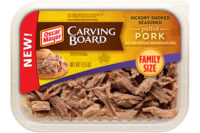Brand owners and consumers want products that are sustainable and convenient. Reclosable packaging addresses both of these needs.
For brand owners, sustainability ranks sixth on their list of operational priorities, according to “Key Challenges for Packaging and Processing Operations,” a white paper published by PMMI, the Association for Packaging and Processing Technologies. As a result, 80% of consumer packaged goods (CPG) companies are making efforts to minimize packaging and reduce waste.
To achieve this goal CPG companies like meat, seafood and poultry processors are designing recyclable packaging, redesigning packaging with more sustainable materials, implementing reusable packaging, and choosing renewably sourced materials, according to “Shaping the Future of Packaging Operations,” a white paper produced by PMMI.
So, it’s no surprise that meat, poultry and seafood processors are looking for convenient as well as sustainable packaging options for fresh, frozen, canned, deli, ready-to-eat, individually quick frozen and preserved products. Reclosable packaging delivers ease of use with environmentally friendly attributes, such as enabling reuse by the consumer, eliminating the need to repackage or rewrap multi-portion products (source reduction), protecting product freshness and reducing food waste. In addition, some reclosable packaging may be recyclable in some curbside programs.
Reclosable packaging options range from rigid and semi-rigid tubs with friction-fit lids to peel-reseal designs and flexible packaging, such as bags with twist-ties and flat pouches or stand-up pouches with slider zippers, press-to-close zippers or adhesive reseal features.
To meet demand for a family-size bag of its frozen whole-muscle chicken breast nuggets, Bell & Evans added a 30-oz. resealable bag to its lineup. Pressure-sensitive adhesive technology allows the bag to be opened and resealed many times and enables the bag to collapse as the product is used.
The stand-up pouch with a press-to-close zipper continues to be a popular option, especially for multi-serving frozen products. This packaging format was chosen for the October 2021 launch of Spicy and Parmesan flavors of Tyson Air Fried Chicken Bites. The 20-oz. pouch holds seven servings of breaded chicken nuggets with 75% less fat and 35% fewer calories than fast-food breaded chicken pieces.
A resealable package for John Soules Rotisserie Seasoned Chicken Breast with Rib Meat, recently won a Silver award for Technical Innovation in the 66th annual Flexible Packaging Achievement Awards competition, sponsored by the Flexible Packaging Association. It was recognized for a laser score that audibly “pops” when opened to provide assurance the package has not been opened previously. The flexible packaging offers both weight and material savings versus rigid alternatives.
Resealability and source reduction also are combined in a design that replaces friction-fit lids with flexible lidstock. The multilayer lidstock relies on a pressure-sensitive, resealable adhesive and reduces lid weight by 30%. When combined with a mono-material tub, the flexible lidstock may improve the likelihood that the package is acceptable in curbside recycling programs.
Paper fiber-based reclosable packaging options offer a way to shift from plastic to a renewable material. In one design for shelf-life-extending modified-atmosphere packs, a thin lidding film provides reclosability. When it’s time to dispose of the package, components are easily separated for recycling.
A formable paper-based option combines a paper tray with a barrier layer with a resealable top web. Compatible with existing form-fill-seal equipment, package components separate easily for recycling.
Peel/reseal structures also may be found in polypropylene (PP). A combination of an easy-peel/reseal, printable lidstock with a formable PP base web provides a mono-material modified-atmosphere package that’s recyclable in programs that accept PP containers. The package also scores source reduction points since it’s 30% lighter than a comparable polyester package.
Tubs with friction-fit lids often are described as “reusable” because after finishing the product, many consumers wash the tub and lid and save it to hold leftovers or non-food items. However, it should be noted that the definition of reuse is evolving as emphasis shifts to moving toward a circular economy. For example, the Sustainable Packaging Coalition defines reusable packaging as packaging that “allows either the business or the consumer to put the same type of purchased product back into the original packaging, is designed to be returnable and/or refillable, and accomplishes a minimum number of reuses by being part of a system that enables reuse.”
It is more important than ever that the packaging and processing industries come together to share insights and innovations, and the best place to do that is PACK EXPO International (Oct. 23-26, 2022; McCormick Place, Chicago) – the most comprehensive packaging and processing show in the world in 2022. From connecting with colleagues and hearing from experts to seeing new technologies, materials, and machinery in action, PACK EXPO International is the most efficient and effective way to discover packaging and processing solutions for over 40 vertical markets. No other event this year will showcase entire production line solutions and offer attendees everything needed to compete in a changing marketplace. For more information and to register, visit packexpointernational.com.




Report Abusive Comment